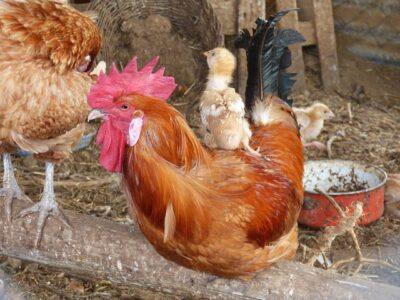Winter is coming, and for those of us who live in snowy climates the task of cleaning our barns and chicken coops is about to get more complicated. One solution is simply to stop cleaning out over the winter and try the deep-litter bedding approach.
You’re probably already covering the floor of your stalls and coops with some kind of high-carbon material like sawdust, shavings, wood chips, leaves, pine needles, hay or straw. Instead of cleaning the bedding out once it’s been covered with manure, just leave everything in place and keep adding a clean layer on top.
The Advantages
Deep litter has several advantages.
First, there’s the convenience. You don’t have to chop through the snow banks between your barn or coop and your compost pile; you don’t have to struggle to pry up frozen-down bedding and break it into manageable shovelfuls or forkfuls.
Then there’s the warmth. As the pile grows deeper, the well-insulated manure and bedding below will begin to compost, creating heat which your animals may welcome on cold nights.
This composting process gives you a head start; in spring you’ll have partially decomposed material instead of raw bedding that has been frozen all winter long.
Diatomaceous Earth: The All-Natural Livestock De-Wormer!
Chickens love to scratch, and deep litter will give them more scope to amuse themselves. The composting litter provides a breeding ground for bugs and worms, which can be a valuable protein supplement. Harvey Ussery, backyard chicken raiser and author of many articles which you can find online, says that deep litter also breeds immune-boosting microorganisms.
The Disadvantages
Deep litter has drawbacks, of course, although most can be avoided with careful management. There’s the mammoth task of cleaning up in spring, when you have a deep, dense, compacted layer of litter to remove. There’s the issue of air quality. Properly managed deep litter will compost fairly cleanly, but if you have too much nitrogen for your carbon-producing materials to absorb you may end up with excess ammonia. This is more likely to be an issue with chicken droppings, which are highly nitrogenous, than with ruminant droppings. Ventilation is also a factor; a tightly sealed building is much more susceptible to air quality problems than an open or very well-ventilated one. There’s also a need for vertical space. My goats may be on deep litter from November through March, and by then their stall floors are two-feet deep in compacted bedding. Remember to think about door height as well as overall stall height.
You’ll need to consider all of these factors in deciding whether deep litter works for some or all of your animals. Here’s how that’s works on my farm in upstate NY, where the winters tend to be cold, snowy, windy and long:
How to Make it Work
I leave my two goats on deep-litter bedding through the winter. They’re in roomy open stalls in a shed that’s open to the outdoors on all but the coldest and windiest nights. I’m able to add enough hay to absorb the nitrogen from their manure and urine so the whole mix composts well. I have noticed the increased warmth of the deep-litter floor. I haven’t had trouble with smells and the goats haven’t had respiratory problems.
My chickens are another story. In summer they have a moving yard and also a fixed compost pile to scratch in. In winter they’re closed into a fairly tight winter coop with a lot of south-facing glass. The coop can get fairly warm on sunny days, and there’s not a lot of air circulating. I don’t use deep bedding for our hens in winter. But some folks do manage well with deep litter for chickens, including Ussery, who lives further down the coast where the winters are milder. He uses Joel Salatin’s recommendation of allowing at least five square feet of floor space per bird. Ussery adds that it’s helpful to bed with coarse materials very high in carbon, like leaves or wood chips; he says the coarseness makes the material easier to scratch up while the high carbon ratio allows the material to absorb more nitrogen. Some farmers report that wet straw in chicken coops is easily colonized by toxic molds; others use straw and say they have no problems.
Pay attention to what works and doesn’t work on your farm. Reading about other people’s experiences can be a helpful starting point, but you can learn most from your own experience. Check the bedding daily; cover over areas that are extremely wet or soiled, and monitor if there’s visible mold. If you notice a mild ammonia smell, add more dry high-carbon bedding. If you have a major or persistent ammonia smell or mold, you may need to muck out after all. Watch whether your animals seem comfortable and healthy. Then tell your friends and neighbors, and perhaps also your fellow readers here, what you’ve learned.
What advice would you add on using the deep litter method? Share your tips in the section below:
Harness The Power Of Nature’s Most Remarkable Healer: Vinegar
 Off The Grid News Better Ideas For Off The Grid Living
Off The Grid News Better Ideas For Off The Grid Living





